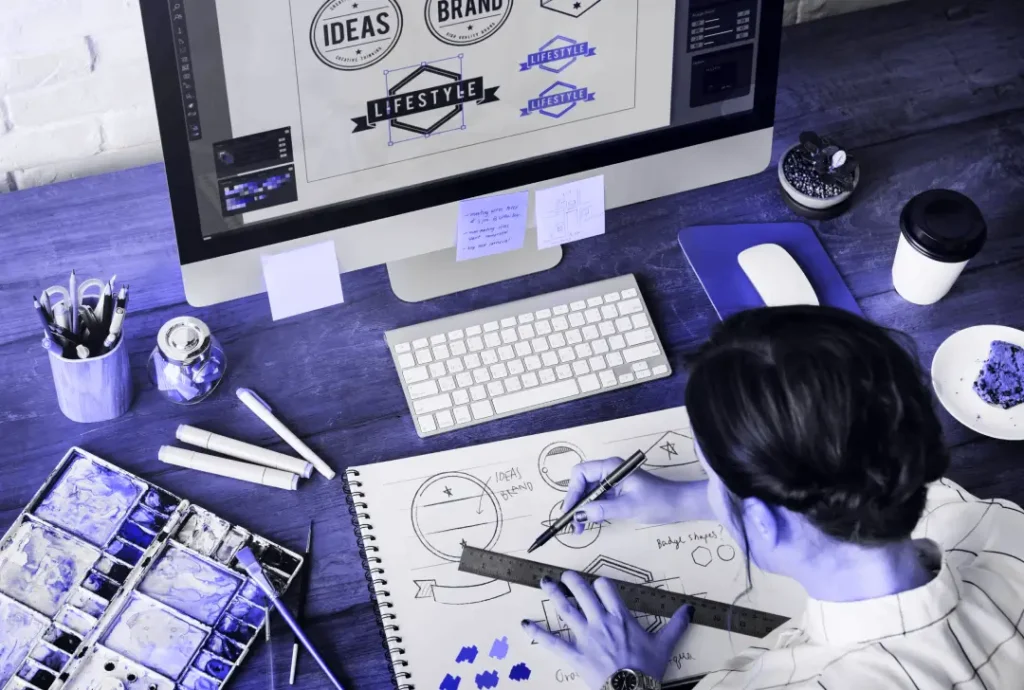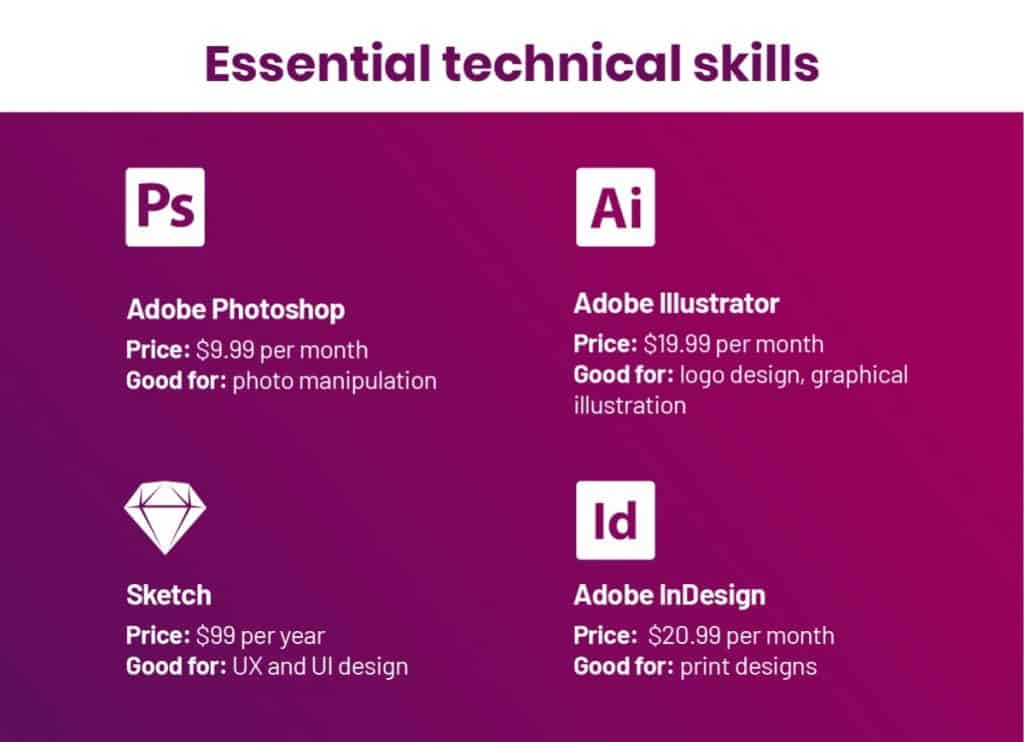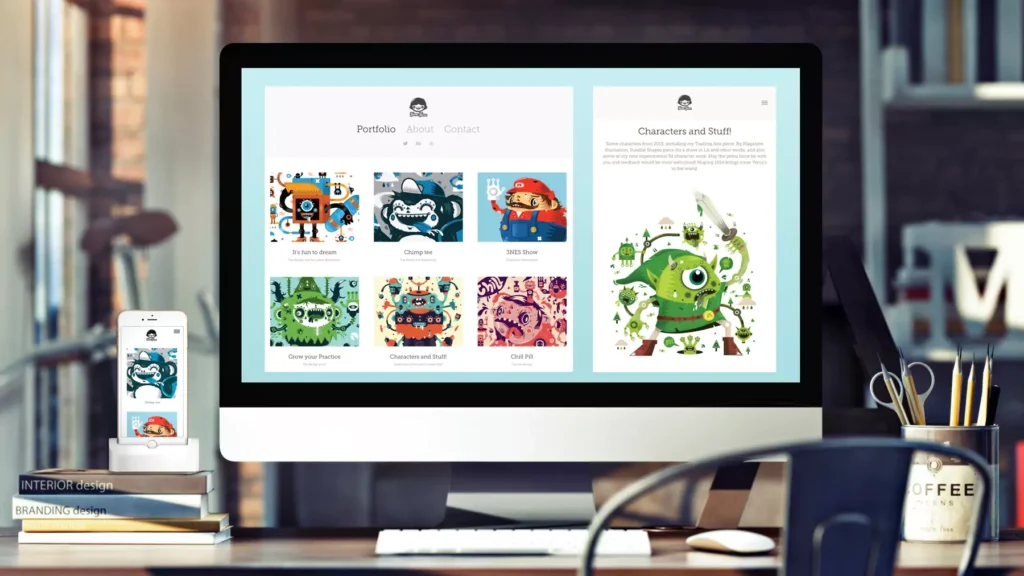Pursuing Careers in Graphic Design: Ultimate Guide
Do you possess creative skills along with visual storytelling ability? If yes, then graphic design might be the best career for you. It is a constantly changing field where art mixes with technology to produce compelling visuals that attract people’s attention while conveying a powerful message.
What does it mean to become a graphic designer? Today, we are going to find out.
We will look at different paths one can take to become successful in this industry, as well as the skills that need refining and exciting opportunities that await individuals who choose it as their profession. So get yourself some coffee or any other drink of your liking because we are about to start an artistic journey together!
Table of Contents
What is Graphic Design, Really?

Before discussing careers in graphic design, let us first examine the essentials. Graphic design is an artistic method of conveying ideas, messages or thoughts through visual content creation. It uses typefaces, pictures, colours, and arrangements to capture attention and feelings or reactions.
Take a minute: every logo, website, book cover, product package or advertisement you have ever seen was designed by someone who works in graphics design. These imaginative experts are like magicians with images; they can shape how we see brands and products – even whole concepts.
The Power of Visual Storytelling
Graphic design is fundamentally rooted in storytelling through visuals. Designers employ their abilities to relate stories visually, evoke sentiments and direct the viewer’s eye across a tactically planned visual journey. This is where aesthetics meets usefulness: each part should contribute towards the bigger picture – from colour schemes to font selections – to communicate effectively.
For instance, just think of flipping through an exquisitely laid out magazine or scrolling down an enthralling website page; layouts merge seamlessly with pictures while typography acts as signposts directing your eyes over different parts of contents until nothing more needs saying. That is what good graphic design can do – it captures attention, educates, and, most importantly, motivates people through their eyes!
Diverse Careers in Graphic Design
One of the most thrilling parts is the absolute range of directions you might take in a graphic design career. Starting with print design and going all the way to digital media, branding or user experience (UX) design, this field has got it all. Let's explore some popular specialisations in detail:
1. Print Design
Print design is where it all began – crafting visually striking printed materials such as books, magazines, brochures or packaging. Even though people have gone digital worldwide, print design remains vital because it combines old-school methods with new techniques.
A print designer works closely with clients to develop layout ideas, choose typography and create graphics that will jump off the page. Attention to detail, knowledge about printing processes, and the ability to make static designs lively are essential skills this sector requires.
2. Digital Design
Designers are needed more than ever in today’s digital age for creating engaging online experiences that captivate audiences across different platforms on the web or mobile apps, etc.… This specialisation involves everything from website development to social media graphics design and digital advertising.
To be a successful digital designer, one must be conversant with current trends in technology-related fields besides knowing the principles governing good designs. Most importantly, these individuals should work with marketers and developers to develop user-friendly, seamless functioning systems that look great and perform flawlessly.
3. Branding and Identity Design
Branding entails the creation of a consistent visual identity for an organisation; the product or service offered by the company concerned helps distinguish it from others operating within similar markets. Branding, therefore, involves the establishment of colour schemes, logos, fonts, typefaces, symbols, images, etcetera, used across different mediums such as physical prints like business cards, pamphlets, posters, labels, packages, envelopes, uniforms, vehicles, buildings, signage, websites portals apps social media handles email signatures among many other touch points.
A branding specialist collaborates closely with their clients to understand what they expect from their brands vis a vis the target audience's needs. They may develop mood boards that reflect desired attributes before developing brand guidelines that will govern all aspects relating to how various elements should be represented consistently throughout different applications and media types, whether physical or digital.
4. User Experience (UX) Design
In the fast-paced world of technology, user experience (UX) design has become an integral part of graphic design. UX designers focus on creating intuitive and easy-to-use interfaces while ensuring smooth navigation through different sections or pages within a website application software, etc.… Such professionals also strive towards achieving optimal usability by making it easy for users to accomplish tasks without encountering difficulties.
User research is carried out by UX experts who then utilise findings from this process while creating wireframe prototypes and collaborating closely with developers until the final product is delivered. Human-computer interaction knowledge and the ability to translate complicated user journeys into visually appealing functional interfaces are essential for a successful career in this area.
Essential Skills for Graphic Designers

It is obvious that to be successful in graphic design, one must possess creativity and an aesthetic sense. However, more than these two abilities are needed for a person aiming to build up his career in this sphere. Here are several necessary skills which should be developed:
1. Technical Skills
Becoming an excellent graphic designer is only possible by learning about programs such as Adobe Creative Cloud (Photoshop, Illustrator, and InDesign). You will need these industry standards to turn your ideas into reality, creating high-quality visual content that meets professional requirements.
2. Skills in Typography and Layout Designing
The basis of any effective graphic design lies in typography and layout design principles. You have to know how fonts work together or against each other when choosing them for your project, what kerning means, which hierarchy has more power over readers' perception, etcetera, etcetera… Moreover, once you start dealing with layouts, cohesion, balance, unity, and readability should also become parts of your vocabulary.
3. Theory of Colours & Composition Techniques
Colors can express emotions, convey messages or create eye-catching effects, thus attracting attention at first sight. You must understand and use colour theory and psychology correctly as a designer. On top of that, composition – the ability to arrange different elements on a page so that they look pleasant together but still carry some meaning individually – is what every creator needs.
4. Communicational & Collaborative Abilities
Collaborating with clients, art directors, copywriters, or any other people involved in the creative process will happen throughout the career path chosen by a graphic designer like yourself! Therefore, communication skills must be strong enough for listening and speaking out ideas clearly while taking constructive criticism and working efficiently within teams.
5. Problem-solving Skills & Analytical Thinking
Designing with purpose requires identifying problems visually and presenting solutions through images effectively; therefore, critical thinking and problem-solving abilities are vital. Every project needs graphic designers who can think on their feet, analyse the client's demands, define the target audience and develop visual concepts that meet specific objectives.
6. Flexibility and Continuous Improvement
This industry changes rapidly due to new methods being discovered or created, like tools for design, techniques used in different areas of graphic design… So, being flexible by continuously learning is necessary if you want to keep up with trends while remaining competitive within the market.
Building Your Graphic Design Portfolio

If you are a recent graduate or a seasoned professional, the best way to get your dream graphic design job is to build a strong portfolio. This visual representation of your abilities, creativity and knowledge should show off what you can do while emphasising your unique styles and techniques.
Tips for creating an impressive graphic design portfolio:
1. Select Your Best Work
Do not be tempted to put too much content in there – quality beats quantity hands down in this case scenario! Carefully choose only those works representing different skills learnt over time and demonstrate growth within oneself as an artist/designer. Remember to include various branding projects alongside print media advertisements, etcetera; everything counts!
2. Weave A Narrative
Let every item tell its tale — from the brief through the process until it was executed successfully against all odds posed by various factors surrounding it. Description paragraphs and mood board sketches should be used to explain the ideas behind them. Consequently, they know how the steps taken were arrived upon, eventually leading to a final decision concerning this particular aspect being addressed here.
3. Flexibility Is Key
Though having one’s unmistakable signature matters quite much, too, there still needs to be the ability to change according to conditions given during a particular project, constantly reflecting the client’s desires and requests. There is no problem if several designs are done differently, therefore displaying a range across diverse sectors like finance, health care, and the music industry, just mention a few among others falling under the general category called “graphic designing”.
4. Update And Refine Regularly
Remember that these records serve as living organisms representing individual achievements thus far reached. Therefore, ensure continuous updating of the latest polished pieces. Work realised so far must appear visually appealing when viewed through channels such as the web, mobile print, etc.
5. Go Digital
In today’s world wide web era, it would only make sense for anyone venturing into any form of artistry, especially graphics designing, to either create an outstanding personal site or utilise famous platforms like Behance and Dribbble where one can easily upload their works also, making them available potential employers who might have interest in seeing more samples prior hiring phases of the job search process.
The Freelance Route: Being Your Boss

While some graphic designers thrive in an agency or in-house setting, others prefer to work as freelancers. They enjoy the liberty and convenience of being their bosses. Besides, freelancing allows you to work with clients, set your schedules, and explore various design fields.
However, one should remember that freelancing has its fair share of difficulties. Managing your finances, finding clients and retaining them can be hard sometimes, especially when working on many projects simultaneously. Therefore, you need self-promotion skills, time management, and client communication to succeed as a freelance graphic designer.
Creating a solid customer base
The success of any freelance graphic designer depends on how well they can build their clientele. Start using your current network, such as friends, relatives or former colleagues who might need design services. You can also attend industry events and join online communities where people post job opportunities related to this field. Social media platforms are another great place to advertise your business, so always be active there.
Where applicable, feel free to make direct approaches, even if it means cold pitching potential customers whose needs match your skills perfectly. All that matters is showing them what you have done before, so having an attractive portfolio website comes in handy alongside activities such as blogging or creating social media visuals to showcase expertise while attracting new clients.
Effective marketing strategies for self-promotion
Self-promotion is essential; freelance graphic designers should learn how best to market themselves. First, you need to identify a design style that represents who you are, then start building personal brand awareness around it, too, like creating professional websites with business cards showing off works done so far, making sure these materials make contact easy for anyone interested.
Also, consider offering discounts on rates charged per project hour or pro bono jobs given to charity organisations dealing with smaller businesses since this way; there will be more chances of getting client referrals later besides testimonials acting as proof of achievements made along the career path.
Dealing with finances plus contracts
Finances are essential in every business, including freelance graphic design; hence, one should be prepared to handle one's own. This means generating invoices and keeping track of expenses incurred while filing tax returns, among other things that may arise during such ventures, to avoid getting caught up by authorities. However, it might also help if one invests in accounting software or hires an accountant who will keep tabs on everything being done, thus ensuring all rules set locally about income declaration are followed accordingly since failure could lead to penalties.
Contract signing is another crucial area to consider when working as a freelancer because it helps protect both parties involved. Therefore, always make sure there is an agreement between you and your client detailing what needs to be accomplished within specified timelines alongside payment terms, including intellectual property rights ownership where necessary so that no misunderstandings occur later on, which might result in legal battles being initiated instead of focusing on completing projects successfully.
Career Progression and Opportunities

There are many growth and development opportunities in the graphic design industry. As you progress and learn more about your craft, you may enter into a niche area, run an agency, or lead a team.
Direction of art and creative leaders
This could be your calling if you have a great portfolio and a track record to match it; this could be becoming an art director or creative director – both roles are managerial positions that involve guiding junior designers while overseeing the overall look and feel (or vision) of each project.
Entrepreneurship or owning agencies
If entrepreneurship runs through your veins, starting up a design firm would tickle your fancy! Apart from having the liberty to shape company culture and attracting cream talent within industry circles, there’s also unlimited potential when it comes down to taking on big-name clients who share similar interests with us…passion meets money-making opportunity at its best.
Teaching others what they need to know
Another rewarding career option is teaching design at higher education institutions such as universities, community colleges, etc., imparting knowledge gained over the years and working in various roles within this field to the next generations so they can follow suit. This way, not only do we get past skills, but we also get a chance to mould future bright stars.
Specialising in consultancy work based around specific sectors within our industry, expertise levels rise then so does the demand for consultants specialised around certain areas, including branding consultancies which advise companies how best visually represent themselves amongst other things would be an example here or user experience (UX) consultants who advise steps organisations should take ensure their platforms remain intuitive users interact with easily.
Finding Your Niche: Design for Specific Industries
Although talents in graphic design can be applied across different fields, some experts prefer to limit their skills to a particular industry so that they can address the unique requirements of that industry. The following are some examples:
1. Design for Publications
Designers for publication create visually attractive layouts for magazines, books, newspapers and other print materials. They work with editors, writers and photographers to produce visually exciting and engaging publications.
2. Design for Packaging
In consumer goods branding, packaging design is essential in attracting consumers and conveying brand values. Product packaging designers make captivating designs that consider shelf appeal, brand recognition, and user experience, among other factors.
3. Environmental and Exhibition Design
Environmental or exhibition designers can design physical spaces such as trade show booths, museum exhibits and retail environments to provide immersive experiences. This involves knowing how people interact with physical spaces as well as creating designs which are both functional and aesthetically pleasing.
4. Motion Graphics/Animation
Motion graphics/animation offers exciting opportunities for individuals who love movement and telling stories through visuals. These designers bring static designs alive with captivating motion effects by creating dynamic visualisations in videos, among other mediums like website animations or interactive experiences.
5. Game Designing
If you are a graphic designer interested in interactive games or virtual reality, this is the best route for your career choice! Gaming involves character creation and interface designing where users can navigate easily through different levels, but not limited to just those aspects alone
The Future of Graphic Design: Embracing New Technologies

The graphic design industry is forever changing as technology advances. The future of graphic design appears vibrant, with many possibilities, such as augmented reality (AR) and virtual reality (VR), interactive design, 3D modelling and more.
1. Augmented Reality (AR) and Virtual Reality (VR)
Graphic designers are leading the way in creating immersive experiences that combine physical objects with digital content through AR and VR. For example, AR-enabled product packaging can create virtual showrooms or interactive exhibitions where people can interact with them.
2. 3D Modeling and Animation
Realistic visualisations have become a crucial part of graphic design due to the rise in demand for it brought about by 3D printing. Using this technique, graphic designers can tell stories and express themselves creatively by designing lifelike representations of characters, products, and environments.
3. Interactive Design and User Experience (UX)
Every day, digital experiences get more complex, thus increasing the need for good user experience design. For an interface to be intuitive and engaging throughout its use, it must blend form with function seamlessly; this is why, now more than ever before, graphic designers work hand in glove with UX designers and developers.
4. Responsive and Adaptive Design
Designers need to ensure that whatever they create looks good on any device regardless of screen size, which is why responsive web designs were invented; however, it’s not enough because people use different devices simultaneously, thus making adaptation necessary. In other words, one should design visually to respond appropriately across platforms, giving users equally optimised views, regardless of what gadget they use.
5. Artificial Intelligence and Machine Learning
Though still at its infancy stage, AI has started finding its way into some areas, including those related to graphic designing tools’ functionalities; this move could potentially revolutionise everything about how we do things currently within this field but mainly by speeding them up through automation or suggesting some designs on behalf of designers themselves thus freeing their minds for more creative tasks.
Frequently Asked Questions (FAQs)
What education or training do I need to be a graphic designer?
A few graphic designers usually hold a bachelor’s degree in graphic design, visual communication or a closely related field. However, the industry could also embrace self-taught designers with exceptional portfolios and skills.
What software programs should I learn for graphic design?
Adobe Creative Cloud’s program suite, including Photoshop, Illustrator, and InDesign, among other design tools, is an industry standard. Learning prototyping and wireframing tools like Figma, Sketch or Adobe XD can also benefit UX/UI design.
How much do graphic designers make on average?
Salaries for this job title vary greatly depending on experience level as well as geographical location within the United States, but according to Payscale.com UK, based employees earn from £20k – £35k per annum with higher salaries going towards more experienced designers or those who undertake specialist roles.
Where can I find jobs in the field of Graphic Design?
You can explore many different avenues when looking for work in this sector, including job boards such as Indeed.com, LinkedIn (jobs) and Monster.co.uk. Design-specific sites like Behance.net & Dribbble.com often feature listings, too, whilst networking events held throughout the year may provide opportunities closer to home if not through agencies themselves whom you could approach directly.
Should I work as an in-house designer or freelance?
Both options have their pros/cons; an “in-house” role offers more stability and benefits such as healthcare coverage, whilst freelancers enjoy more significant freedom/flexibility, choosing hours worked, etc., plus working across multiple clients/projects simultaneously if desired. However, choice will depend upon individual preferences/career goals.
How do I stay up-to-date with design trends and technologies?
Attend industry events (such as conferences/trade shows), take online courses/workshops via sites like Udemy.com, follow influential design blogs/social media accounts that regularly cover these topics, + expand your skillset continually so that it stays active within an ever-changing creative landscape!
What can I do to create a solid graphic design portfolio?
Ensure it’s up-to-date with your best work, show diversity by displaying the range (different styles/applications), explain the background behind each project undertaken, and finally, keep it polished as a physical or online presence. Just remember – first impressions count!
How important is networking for graphic designers?
Networking is vital within any industry, especially in such a competitive field as graphic design. Attending events where professionals gather together (such as design conferences) whilst joining relevant organisations like The Designers Guild will help build relationships with peers/clients and provide valuable contacts over time, which could lead to future job opportunities/projects.
